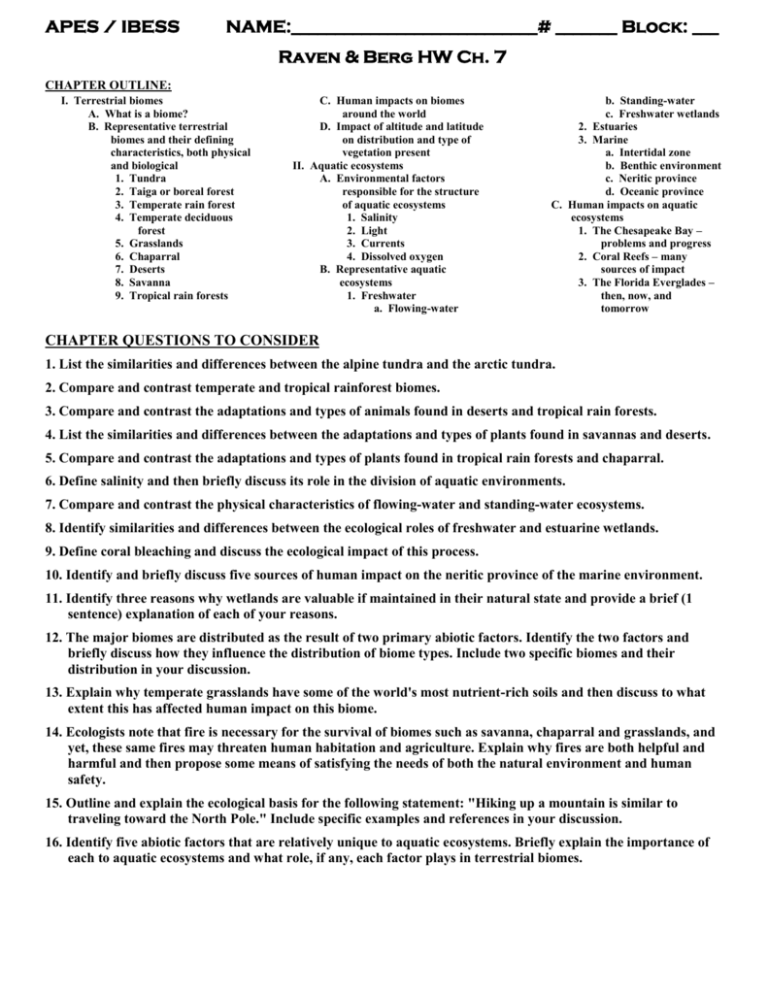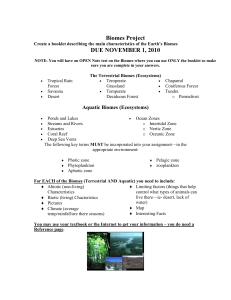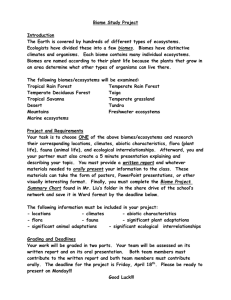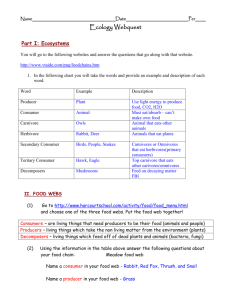CH 7 HW 11
advertisement

APES / IBESS NAME:____________________________# _______ Block: ___ Raven & Berg HW Ch. 7 CHAPTER OUTLINE: I. Terrestrial biomes A. What is a biome? B. Representative terrestrial biomes and their defining characteristics, both physical and biological 1. Tundra 2. Taiga or boreal forest 3. Temperate rain forest 4. Temperate deciduous forest 5. Grasslands 6. Chaparral 7. Deserts 8. Savanna 9. Tropical rain forests C. Human impacts on biomes around the world D. Impact of altitude and latitude on distribution and type of vegetation present II. Aquatic ecosystems A. Environmental factors responsible for the structure of aquatic ecosystems 1. Salinity 2. Light 3. Currents 4. Dissolved oxygen B. Representative aquatic ecosystems 1. Freshwater a. Flowing-water b. Standing-water c. Freshwater wetlands 2. Estuaries 3. Marine a. Intertidal zone b. Benthic environment c. Neritic province d. Oceanic province C. Human impacts on aquatic ecosystems 1. The Chesapeake Bay – problems and progress 2. Coral Reefs – many sources of impact 3. The Florida Everglades – then, now, and tomorrow CHAPTER QUESTIONS TO CONSIDER 1. List the similarities and differences between the alpine tundra and the arctic tundra. 2. Compare and contrast temperate and tropical rainforest biomes. 3. Compare and contrast the adaptations and types of animals found in deserts and tropical rain forests. 4. List the similarities and differences between the adaptations and types of plants found in savannas and deserts. 5. Compare and contrast the adaptations and types of plants found in tropical rain forests and chaparral. 6. Define salinity and then briefly discuss its role in the division of aquatic environments. 7. Compare and contrast the physical characteristics of flowing-water and standing-water ecosystems. 8. Identify similarities and differences between the ecological roles of freshwater and estuarine wetlands. 9. Define coral bleaching and discuss the ecological impact of this process. 10. Identify and briefly discuss five sources of human impact on the neritic province of the marine environment. 11. Identify three reasons why wetlands are valuable if maintained in their natural state and provide a brief (1 sentence) explanation of each of your reasons. 12. The major biomes are distributed as the result of two primary abiotic factors. Identify the two factors and briefly discuss how they influence the distribution of biome types. Include two specific biomes and their distribution in your discussion. 13. Explain why temperate grasslands have some of the world's most nutrient-rich soils and then discuss to what extent this has affected human impact on this biome. 14. Ecologists note that fire is necessary for the survival of biomes such as savanna, chaparral and grasslands, and yet, these same fires may threaten human habitation and agriculture. Explain why fires are both helpful and harmful and then propose some means of satisfying the needs of both the natural environment and human safety. 15. Outline and explain the ecological basis for the following statement: "Hiking up a mountain is similar to traveling toward the North Pole." Include specific examples and references in your discussion. 16. Identify five abiotic factors that are relatively unique to aquatic ecosystems. Briefly explain the importance of each to aquatic ecosystems and what role, if any, each factor plays in terrestrial biomes.








